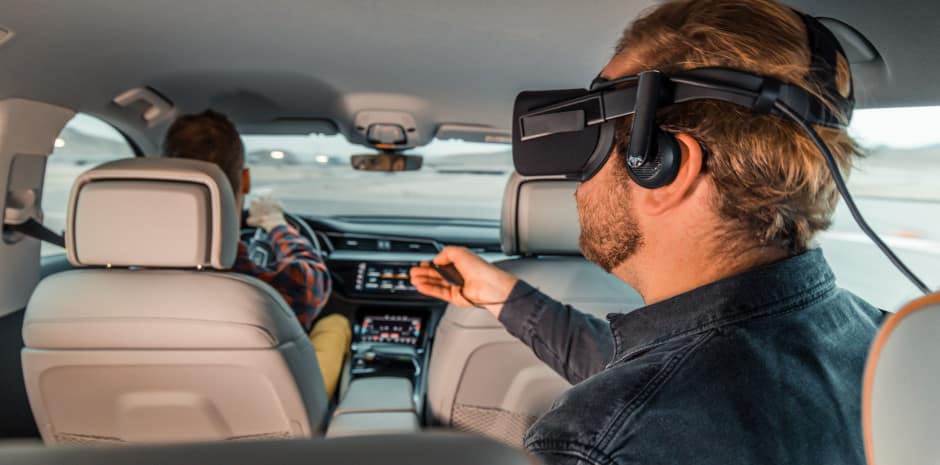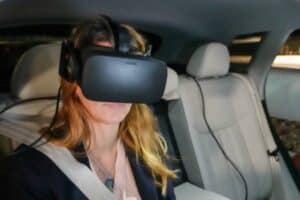A couple of interesting projects surfaced recently involving VR and cars. One is based on patents from the ride-sharing service Lyft, the other from Audi’s announcement at CES 2019.
Both are fascinating for how they could redefine travel. And how it might expand our entertainment and educational options. And down the road, the technology might just resolve the motion-sickness issue with virtual reality.
Surely, if we can compensate for the motion of an automobile on a highway in VR, we should be able to help someone who is feeling queasy as they walk around a room in a headset.
VR and cars – Lyft

Lyft has plans to integrate both VR and AR into their services. The augmented reality side is just basic practicality. It’s often difficult to figure out where your rideshare car is located, especially at night or a crowded area such as an airport or train station.
Washington Union Station is one of the worst places to get Uber or Lyft – we’ve got into the habit of walking half a block away from the terminal – it’s just easier to find your car (which is also not stuck in the line in front of the station).
You can readily see the convenience of a digital arrow hovering over a car you’ve summoned. And once we get lightweight AR Glasses like the Nreal model at CES 2019 the other week, we’ll all be doing this.
On the other hand, the VR project for Lyft focuses on entertainment. Here’s Tech Crunch on the patent.
The first, filed in July 2017, is for “providing a virtual reality transportation experience” that would respond to real-world forces and events that happen during your ride, like sudden stops, turns and bumps in the road. Over time, the VR system would be able to predict those bumps and turns in the road.
From there, the VR system would generate a virtual experience with virtual interactions based on the real-world environment. Specifically, the VR system may include, “but are not necessarily limited to, virtual collisions with objects, virtual turns, virtual drops, etc.” That sounds mildly horrifying, but it would definitely make for an unforgettable ride. Other ideas of virtual experiences feature a game with lasers and flying saucers.
It doesn’t seem like the most feasible solution, especially since those bumps and turns in the road are always changing (especially in urban areas).
Audi’s Holoride

On the other hand, the Audi VR project is fascinating. At CES 2019, they announced the spinoff of a new company, Holoride, that is working on bringing virtual reality to our cars.
They take a much broader approach. The platform will be open-source and available to any automotive brand. It’s similar to what Volvo did in the 1950s when they gave away their patent on the three-point seat belt.
The interesting piece is what Holoride plans to do with this tech. The company is keen on making this an open platform and agnostic in every way.
Holoride hopes to have a software development kit out by the end of the year that it can share to content and game developers.
Entertain, education, training. All of these might be done some day while sitting in the back seat of a car. And in the front seat once we have self-driving vehicles. You can get a sense of what it might be like in the video.
Both projects are fascinating, but Audi’s Holoride has much more potential with its open-source approach. And solving the challenge of using virtual reality in a moving vehicle could lead to a resolution of motion-sickness with VR.
Down the road, you could see this being part of Elon Musk’s Hyperloop system. We’ll need some way to get around the claustrophobia of rushing through a tube at 700mph.
Both of these projects involving VR and cars will do more than create immersive experiences. Paradoxically, they will bring activities in the real world into our virtual environments.
The real getting incorporated into the virtual. Let that sink in for a moment. It’s another mark of how different our future world will be.
Emory Craig is a writer, speaker, and consultant specializing in virtual reality (VR) and artificial intelligence (AI) with a rich background in art, new media, and higher education. A sought-after speaker at international conferences, he shares his unique insights on innovation and collaborates with universities, nonprofits, businesses, and international organizations to develop transformative initiatives in XR, AI, and digital ethics. Passionate about harnessing the potential of cutting-edge technologies, he explores the ethical ramifications of blending the real with the virtual, sparking meaningful conversations about the future of human experience in an increasingly interconnected world.

